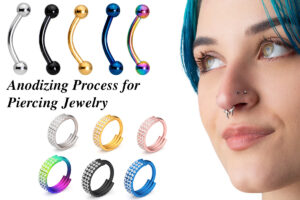Introduzione: Why Target Market Matters in Piercing Jewelry
Piercing jewelry is not just about aesthetic appeal—it’s a personal statement that varies significantly across target markets. Factors like age, gender, culture, and material preferences influence purchasing decisions, making it vital for businesses to tailor their offerings. In this article, we’ll explore how to select gioielli penetranti in diversi mercati to ensure your products resonate with your audience while staying competitive in this fast-growing industry.

1. Understanding Market Segments in Piercing Jewelry
UN. By Age Groups
1. Teenagers (13-19 years old)
• Preferences: Trendy and affordable options such as acrylic, anodized titanium, or glow-in-the-dark designs.
•Popular types: Ear studs, cartilage hoops, and septum rings.
•Consideration: Low-cost, non-toxic materials to match their limited budgets.
2. Young Adults (20-35 years old)
• Preferences: Minimalist designs with high-quality materials like 316L surgical steel or G23 titanium.
•Popular types: Nose rings, belly button studs, and unisex barbells.
•Consideration: Durability and style to align with their professional and social lifestyles.
3. Mature Consumers (35+ years old)
•Preferences: Timeless and elegant styles, often in gold or platinum.
•Popular types: Orecchini, borchie, and simple hoops.
•Consideration: Hypoallergenic properties and premium craftsmanship for lasting appeal.
B. By Gender
1. Women
•Common preferences: Feminine designs with gemstones or floral patterns.
•Popular types: Belly rings, borchie, and dainty earrings.
•Trends: Lightweight jewelry with bright or pastel colors.
2. Men
•Common preferences: Bold, edgy designs like spikes, black steel rings, and industrial barbells.
•Popular types: Eyebrow rings, lip studs, and large hoops.
•Trends: Minimalist but statement-making styles for modern masculinity.
3. Unisex Designs
•Common preferences: Neutral, sleek designs like plain barbells or hoops.
•Popular types: Septum rings, cartilage studs, and labrets.
•Trends: Rising demand for gender-inclusive designs in progressive markets.
C. By Culture and Region
1. America del Nord
•Key trends: Septum rings, navel piercings, and alternative styles inspired by celebrities and social media.
•Preferred materials: Titanio, acciaio chirurgico, and bio-resin for sensitive skin.
2. Europa
•Key trends: Simple, elegant designs in gold or silver.
•Popular piercings: Cartilagine dell'orecchio, nose hoops, and lip studs.
3. Asia-Pacific
•Key trends: Discreet, minimalist jewelry styles.
•Cultural considerations: Piercings are often limited to ears and nostrils due to conservative norms.
4. Middle East
•Key trends: Nose studs and earrings in 18k gold.
•Cultural considerations: Jewelry is deeply tied to tradition and luxury aesthetics.
2. Key Factors for Choosing Piercing Jewelry in Different Markets
UN. Material Preferences
•High-End Markets: Oro, platinum, and diamond-encrusted jewelry cater to luxury buyers.
•Hypoallergenic Markets: Titanium and 316L surgical steel are essential for sensitive consumers.
•Budget Markets: Acrilico, silicone, and anodized aluminum offer affordable options for price-conscious shoppers.
B. Certification and Safety Standards
•ASTM and ISO certifications for material safety.
•Ensuring nickel-free and lead-free compliance in all products.
C. Popular Styles by Piercing Type
1. Orecchini: Versatile and universally popular.
2.Gioielli per il naso: Hoops and studs dominate globally.
3.Lip and Labret Studs: Popular in alternative fashion markets.
4.Belly Rings: Trendy among younger female consumers.
5.Anelli del setto: A growing trend in unisex and alternative markets.
3. Trends Shaping the Piercing Jewelry Market
UN. Sustainability and Eco-Friendly Materials
•Increasing demand for eco-friendly piercing jewelry like bio-resin and recycled metals.
•Brands incorporating sustainability into their marketing gain consumer trust.
B. Influence of Social Media
•Platforms like Instagram and TikTok drive fashion trends for piercing jewelry.
•Collaborations with influencers can boost product visibility.
C. Customization and Personalization
•Consumers favor jewelry that reflects their personality, such as engraved pieces or unique designs.
4. Marketing and Positioning Strategies
UN. Catering to Emerging Markets
•Expanding into Asia-Pacific, where urbanization and shifting cultural norms increase demand.
•Offering discreet and minimalist designs tailored to conservative regions.
B. Leveraging E-commerce
•Building robust online stores with user-friendly interfaces.
•Providing detailed product descriptions, including material certifications and care instructions.
C. Highlighting Value Propositions
•Stressing hypoallergenic materials for sensitive skin.
•Marketing eco-friendly piercing jewelry to environmentally conscious buyers.
5. Challenges and Opportunities in the Piercing Jewelry Business
UN. Challenges
1.Navigating cultural and regional sensitivities.
2.Ensuring material safety and compliance with global standards.
3.Standing out in a saturated market.
B. Opportunities
1.Rising global demand for sustainable and premium materials.
2.Expanding customization services for niche markets.
3.Leveraging social media to target younger demographics effectively.
Conclusione
Scegliere il diritto gioielli penetranti in diversi mercati requires a deep understanding of target demographics, cultural influences, and material preferences. By tailoring designs to the specific needs of each market, businesses can not only meet customer expectations but also gain a competitive edge. Whether focusing on premium gold designs for luxury markets or sustainable options for eco-conscious buyers, the key lies in staying adaptable and responsive to evolving trends.
Recommended Internal Links







